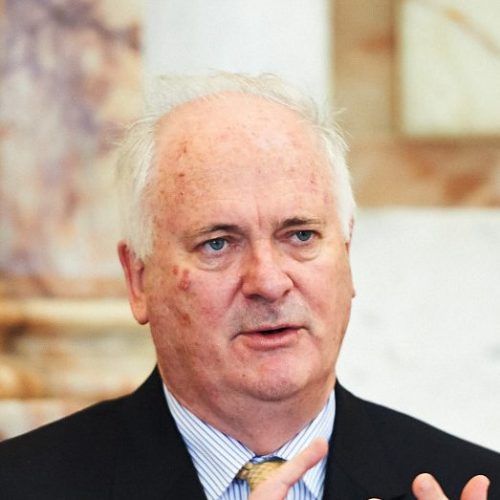Will Theresa May's five tests for Brexit do more harm than good?
#CriticalThinking
Former prime minister of Ireland and Trustee of Friends of Europe
John Bruton is Advisor to Fair Observer and Prime Minister of Ireland’s Rainbow Coalition government (1994-1997) and Trustee of Friends of Europe
Watching Theresa May’s speech at the Mansion House on 2 March, one thing seemed clear: the United Kingdom is putting itself, as well as all the other European Union member states, to a lot of trouble, so that it can leave the EU and then simultaneously re-join the block in selected areas.
The UK wants a partnership with the EU on customs, on state aid and competition, on transport, energy, broadcasting, financial services, atomic power and aviation as well as on the enforcement of court judgements. And the list goes on to cover other fields.
As a current EU member state, the UK already has a partnership with the 27 countries of the EU on all these things. This relation has been created and maintained over 45 years of UK’s EU membership. The UK now wants to tear up this existing relation and negotiate a new partnership ‒ and it wants to get the job done within two years. All this is being done in the name of “taking back control” but it seems that, in many areas, control is being taken back only to be given away again. A lot of work for very little product!
Just as former British prime minister Gordon Brown had five “tests” for joining the euro, Theresa May has five tests for an acceptable Brexit outcome.
We have a long way to go on this unproductive, time-wasting and tragic road to Brexit
Originally, the UK was promising a frictionless border in Ireland. In her speech, May seemed to retreat from that, speaking of a border that would be “as frictionless, as possible”.
May’s idea of a Customs Partnership, to avoid a hard border in Ireland, seemed like a smuggler’s charter, however. She envisages that the UK would have different rates of tariffs on goods entering the UK to the tariffs charged on goods entering the EU. She then suggests that the UK would charge the UK tariff on goods “intended” for the UK, and a different EU tariff on goods passing through the UK but “intended” for an EU country, most likely Ireland.
In this way, May hopes no customs checks would be needed at the Irish border or in Irish ports. The scope for abuse, and exchange of goods, seems unlimited. Consignments could be substituted for one another, and there would be no check on them when they crossed the Irish border. Such an arrangement would be very difficult to police and is unlikely to satisfy the EU Customs Code. If the EU and the UK are to have different rates of tariff, May’s idea of exempting small businesses along the Irish border from any control at all seems like an invitation to smuggle. Presumably, she will want the EU Customs Code amended to take on her ideas. But if that is done, similar concessions will be demanded along all the other borders to which the Customs code applies, such as the EU borders in Eastern Europe.
The most valuable test that May wishes to apply to a Brexit agreement, however, is that it should be one that would endure, and not require, constant renegotiation. Yet, some of her other statements make it very difficult to pass that test.
May stressed that any trade agreement with the EU could be changed afterwards by the UK Parliament, while at the moment the UK Parliament cannot overrule an EU rule to which the UK has previously agreed. After Brexit, any future UK/EU trade agreement would be subject to the vagaries of British politics. That if anything creates instability and prevents building a solid base for investment.
Furthermore, May ruled out the UK Courts accepting the decisions of the European Court of Justice (ECJ) on many disputed matters. While she said that the UK Courts would “look at” ECJ rulings before making their own decision, this will gradually lead to divergence between the UK and EU/ECJ interpretations of cases and law. When that happens, renegotiation and uncertainty will be inevitable.
Theresa May has five tests for an acceptable Brexit outcome
May is pushing for the idea of an “arbitration mechanism” independent of the EU and the UK instead. That might work for a country which trades a limited number of products with the EU but, as stated by May herself, she wants an agreement that would cover more subjects that any trade other agreement anywhere else in the world.
One of May’s tests for an acceptable Brexit was that it would strengthen the Union between the four “nations” that make up the UK.
But the process of Brexit itself is having the opposite effect. In the way the referendum was set up, the majority of English and Welsh “Leave” voters were allowed to overrule the majorities of “Remain” in the two other “nations”, Scotland and Northern Ireland. One could say that the Brexit Referendum was a crude exercise for English power to satisfy a purely English political agenda.
While it was good that May finally got into some details in her speech, the text of the Withdrawal Treaty is not yet agreed on. That must be done before the substantive negotiations can begin on matters highlighted at the Mansion House.
But the fact that the UK has yet to come up with a legal text of its own for the Withdrawal Treaty, to reflect the agreement Theresa May made in December 2017, while virulently criticising the EU version, shows that we have a long way to go on this unproductive, time-wasting and tragic road to Brexit.
Stay informed
